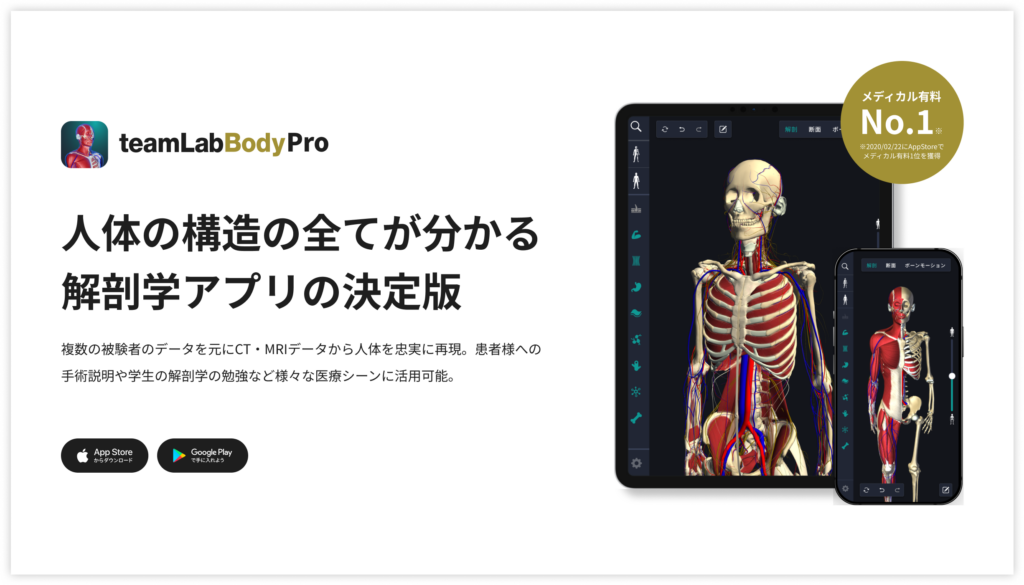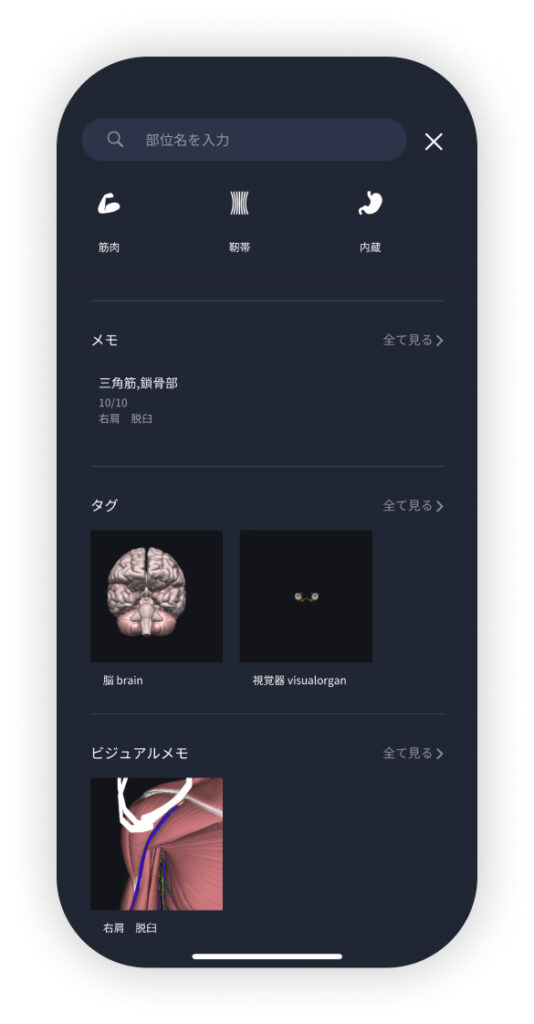beginning
In this article, I will explain effective study methods, starting with knowledge of specialized parts in human anatomy.
In human anatomy, it is necessary not only to memorize the names of various organs, muscles, and bones, but also to remember where they are located in the body. Therefore, it is necessary to learn as efficiently as possible.
I hope you will deepen your understanding even a little by reading this article and using the app.
Now, I will explain the contents of “stylomandibular ligament and stylohyoid ligament” and how to study human anatomy.
teamLab Body Pro Free Download
A 3D anatomy app that shows all the structures of the human body
Download teamLab Body Pro here!

What are stylomandibular ligament and stylohyoid ligament?
The anatomy application allows you to view a selection of anatomy 3D models. In this model, there are various observation methods such as surfaces, cross-sections, and nervous systems. This time, I'll explain using an anatomy application.
About stylomandibular ligament

The stylomandibular ligament is a connective tissue ligament that occurs from a stem-like process on the temporal bone and attaches to the inside of the mandibular horn. It acts as an auxiliary support structure for the temporomandibular joint and helps stability during chewing movements while restricting excessive forward movement of the lower jaw.
Also, it exists independently of the joint capsule and has a positional relationship adjacent to the pterygoid mandibular muscle and posterior abdominal muscle of the diabdominis muscle.
In addition to static support, it also plays an auxiliary role during movement, so it is important for understanding the functional anatomy of the temporomandibular joint.
About stylohyoid ligament

The stylohyoid ligament is a ligament that runs from the styloid process of the temporal bone to the small horn of the hyoid bone, and works as part of the hyoid suspension device. This ligament is linked to the movement of the hyoid bone and related tongue/pharyngeal muscle groups, and supports stable movement during swallowing and speech.
Also, when ligaments ossify, they can cause “eagle syndrome,” and it is an important structure in clinical diagnosis. It is an essential ligament for learning deep neck anatomy and dynamic musculoskeletal linkage.
Study points
Anatomical understanding: accurately capture structure and positional relationships
The stylomandibular ligament and stylohyoid ligament are both ligaments that begin from the styloid process of the temporal bone, and are central landmarks of cervical anatomy. The stylomandibular ligament runs backward and downward from the styloid process toward the mandibular angle, and is an auxiliary stabilizing structure for the temporomandibular joint. Meanwhile, the stylohyoid ligament faces the small angle of the hyoid bone and is deeply involved in the movement of the tongue, larynx, and pharynx as part of the hyoid suspension device.
In order to accurately understand the location of these ligaments, it is important to first clearly hold down the three points of the temporal bone, mandible, and hyoid bone. By using a 3D application, memory retention is enhanced by visually confirming the actual driving direction and positional relationships with other muscles and nerves.
Functional understanding: learning in relation to movement
These ligaments are not only static support, but also indirect support structures involved in dynamic movements such as chewing, vocalization, and swallowing. By actually performing masticatory movements and movements that move the tongue back and forth while thinking “what structure supports behind this movement,” the role of ligaments, which was abstract, becomes concrete.
In particular, the stylohyoid ligament acts as a movable fulcrum when the hyoid bone is pulled up during swallowing, so understanding deepens when observing swallowing movements while focusing attention on the throat.
Practical application: deepening from clinical relationships
“Eagle syndrome,” which develops when the stylohyoid ligament ossifies and stimulates surrounding nerves, is a clinically important disease. In this syndrome, pain in the throat during swallowing, discomfort in the back of the ear, and abnormal facial nerve sensation appear. If you learn from the viewpoint of what structures ligaments pass near and which nerves they affect, it becomes clear how anatomical knowledge is used in actual diagnosis and treatment. By learning as a “connection with pathology” rather than simply a structure, the ability to apply knowledge increases dramatically.
How to study human anatomy
I will explain specific study methods using human anatomy applications.
Check your past learning history and practice repeatedly
Here are the steps to check your anatomy learning history and practice iteratively effectively.
1. Check your learning history in the app
Reviewing your learning history with the application is an important step in effectively advancing anatomy learning. First, launch the app and go to the learning history section from the main menu. Many anatomy apps are designed to show your progress in the form of graphs and lists, so you can visually check which parts you've learned about and how much time you've spent.
By using this data, you can understand which areas you have strengths in and where you need to spend more time and effort. We also recommend using a dedicated tag or notebook function to mark areas you are particularly weak at or where you need to relearn. Regularly checking your learning history and looking back on past learning content will lead to efficient review and deepening understanding.
2.Make a plan for iterative learning
Making an efficient repetitive learning plan based on learning history is extremely effective in promoting knowledge retention. First, identify weak points and areas where you need to relearn. Next, arrange these study items into a weekly or monthly calendar and create a specific study schedule. By proceeding in a planned manner, you can learn each part evenly and avoid packing in a large amount of information at once.
Using a task management app or digital calendar to set study reminders is effective. Also, it's important to have the flexibility to regularly review progress and revise plans as needed. By having goals and proceeding with your studies in a planned manner, you can efficiently acquire anatomical knowledge.
3.Use 3D features to learn visually
By utilizing the 3D function, learning anatomy is easier to understand visually. The 3D model shows the structure of the human body three-dimensionally, and each part can be observed in detail. This makes it possible to intuitively grasp positional relationships between deep muscles and organs that are difficult to capture in a planar view. For example, you can learn even the smallest details by rotating specific muscles and bones and zooming in and out.
Also, there are many apps that have the function of displaying cross-sectional views of each part using a 3D model, which is useful for deepening understanding of internal structures. This diversity of visual information helps with memory retention and improves immediate responsiveness in tests and practice situations. By utilizing the 3D function and learning visually, you can learn anatomy knowledge more deeply and efficiently.
Use the memo function concretely

Make notes so you don't forget the things and points you've noticed while studying. The memo function can be used for different purposes, such as inputting text, saving images, and writing memos. Tag your notes to make them easier to review later.
Test your learning regularly in the form of quizzes
Regularly testing what you've learned in a quiz format is a very effective way to anchor your anatomy knowledge. Quiz-style tests help you objectively grasp your level of understanding and areas you lack while repeating knowledge.
For example, by using a learning app to conduct quizzes every specific period, you can reconfirm what you've learned and strengthen your memory. There are a wide range of quiz formats, such as multiple choice questions, fill-in-the-blank questions, and short answer questions, and each helps understanding from a different angle and develops the ability to utilize various types of knowledge.
Get feedback
If possible, get feedback from other learners and experts. It helps you find your own gaps in understanding and areas for improvement. You can also keep yourself motivated to learn by regularly testing yourself. Feeling a sense of accomplishment and progress increases motivation for continuous learning.
summary
This time, I explained how to study “stylomandibular ligament and stylohyoid ligament” using an application!
Thank you for reading this far.
I would be happy if reading this article helped you learn about anatomy.
Learning is a long, never-ending journey, but I sincerely wish you all the best. Let's continue to study together and work hard for the national exam!
Please look forward to the next blog.
teamLab Body Pro Free Download
A 3D anatomy app that shows all the structures of the human body
Download teamLab Body Pro here!





